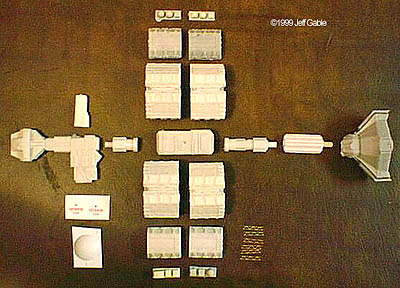

|
By Jeff Gable - photos and text © 1999
|
|
|
Planet X's Leonov from "2010: The Year We Make Contact" comes in a very flimsy box (shirt cardboard quality), but all components are in stapled or ziploc plastic bags surrounded by styrofoam peanuts. There is a single instruction sheet, which consists of one exploded drawing, which is difficult to decipher because it isn't a perspective drawing but rather a side profile. The bottom half of the sheet contains some general assembly notes. 
The kit scale is noted as 1/290th, the same as Planet X's earlier Discovery kit. That scale seems to be in the right ballpark. Informed calculations put it at about 1/305. Close enough. The finished model measures 11" in length and 5" wide at the rotating section. Parts Quality The kit consists of twenty resin, one vacuform, six brass, two aluminum tube, and fifty-eight white metal parts. The white metal reminds me of the metal used for the FASA Renegade Legion: Interceptor miniatures. It is very fine, no grain at all, and shiny. The resin is nice as well. For starters, there are no pour stubs! Also the central components feature predrilled holes to allow the center them to rotate. If you choose the rotation option you'll have to come up with another way to mount the ship on the stand. Maybe use a method like that used for Revell's Babylon 5 station? The brass pieces are very fine and represent small girders that connect the rotating modular pieces together. Did I mention how impressed I was with the white metal pieces? There are forty-eight separate radiators for the engine section, very nicely molded with a very tight grid pattern. However, there is a little flash on them, which is easily trimmed off. The Main Assemblies The engine section is really nice, with detail in all of the engine nozzles. There are a few pinholes here and there, and some airholes in the back of the modular sections of the center section, but I don't think these will be visible on the completed kit. This is light years ahead of this company's Discovery kit! All the center hull components use holes and tubes to fit together, and they all fit tightly. Other than the aluminum tube used on the center section, the rest use resin pins the same size as the tube to mate with the opposing piece. On The Downside If there is a disappointment in the kit, it is with the stand....an utterly featureless rectangle of resin with a hole drilled in the middle for the included aluminum rod. It looks like a large switch plate cover. It even has the same beveled edges. Oh yeah, the vacuform parabolic antenna has no detail at all, but a little Evergreen strip can fix that...or simply replace it. In The Final Analysis... I compared the parts to the photos and drawings in "The Art of 2010", which I know is a pretty sparse reference. By that measure, the command section looks too thin, but overall the kit looks great. The bottom line is that I feel the Leonov is worth the $85 I paid. I picked mine up through Q's Continuum. |
Click any image below ^ A closeup of a few of the main components to show the detailing. ^ All the white metal parts. Note the flash around the radiator segments, it is very thin and easily trimmed. ^ A closeup of the detailing in the engine module. Very nice. ^ Closeup of the docking collar, a couple of the radiator segments, and detail pieces for the ends of the rotating section. Note the shiny finish. The pointy piece at the right is the antenna mount (the point goes through the vac dish). ^ A closeup of the photoetch (or fine brass) girder detail pieces for the rotating section. ^ The decal sheet and the vac dish antenna. ^ A shot of the stand components. Of the two aluminum tubes, one is for the stand and the other (longer) one is for the rotating section. |
![]()
This page copyright © 1997-9 Starship Modeler™.
Last updated on 15 July 1999.